Alejandro González Iñárritu’s Birdman is the story of Riggan Thomson (Michael Keaton) playing a Hollywood actor past his prime – once famous for the superhero Birdman but now trying to kickstart his career as a Broadway producer and thespian. The film is presented in one seemingly long continuous take, thanks to the efforts of Gravity cinematographer Emmanuel ‘Chivo’ Lubezki, who also helps illuminate Riggan’s complex relationship with his alter ego during several hallucinatory events. Whilst certainly not a large scale visual effects film, Birdman features numerous seamless invisible shots, including the long takes and the odd events that happen around Riggan. Helping to bring those to the screen was Montreal studio Rodeo FX headed by President Sebastien Moreau. We find out how some of the key shots were achieved from visual effects supervisor Ara Khanikian.
Super-human
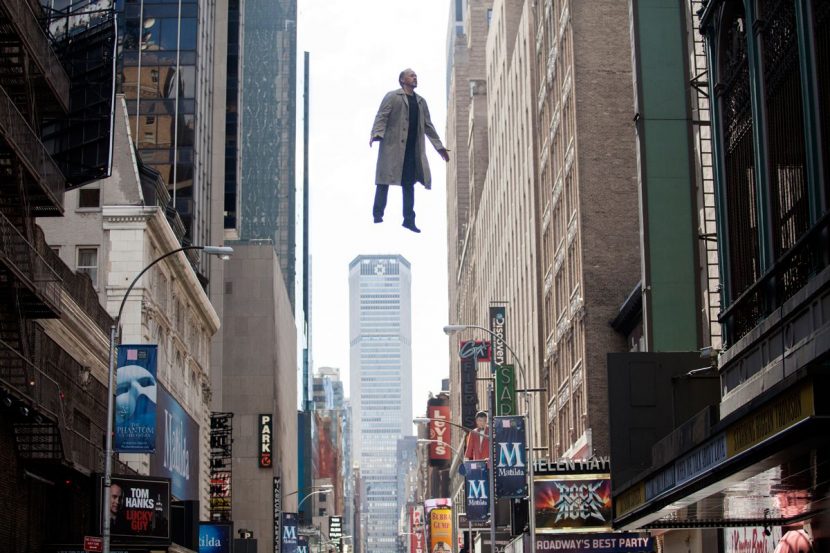
The shot: In perhaps one of the most elaborate effects in the film, Riggan re-imagines himself as his alter ego Birdman and levitates above the streets of New York before taking flight around the city.
The effects: The flying sequence was heavily previs’d, with background plates and HDRs shot to match. The initial levitation was captured with an on-set wire rig lift. Keaton was later filmed against greenscreen and lit with LED light panels – similar to the technique Lubezki had used on Gravity – featuring HDR imagery of the locations, with final shots completed by Rodeo.
Halon completed previs for the flying shots, while Rodeo also contributing techvis passes to help with planning both the New York background plate camera moves and how Keaton would later be acquired on stage in Montreal. “We didn’t have access to motion control or repeatable heads of any sort,” says Khanikian, “so we really had to find creative ways of shooting him and getting technically what we needed. We did the techvis to show where the camera had to start and make sure it matched with what was shot months ago in New York.”
In New York, Lubezki filmed plates that matched the choreography of the previs, while also planning to light the greenscreen Keaton as closely as possible to these plates. “Chivo had the great idea of adding four GoPro cameras mounted on the lens of the film camera,” explains Khanikian. “So while he was shooting the background plates he was actually capturing a 360 environment that he would eventually put in his LED panels to light Michael Keaton.”
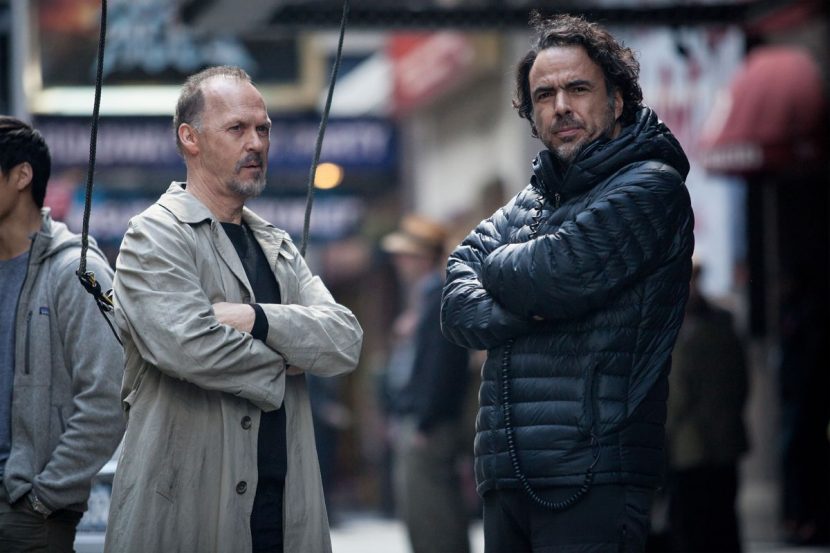
“For those kinds of shots,” adds Khanikian, “most of the time the most difficult thing is to nail the lighting, and this process really assured us that at least the lighting is going to match. So when Riggan goes inside or outside of the building or in the light or the shadow, he reacted properly to those cues.”
After the New York plate shoot, Rodeo assembled the footage that was mocked up in layout form. “We basically revisited the previs that Halon had done but with the proper backdrops that were shot,” says Khanikian, “and extracted out of that all the data we needed to shoot Michael Keaton on greenscreen.”
Keaton was then filmed in a wire rig on a greenscreen stage in Montreal, lit by the LED panels displaying the New York HDR images. “We had our camera set up and we would reference the techvis with all the necessary cues,” explains Khanikian. “Everything was so precisely timed just like the rest of the movie – cues for the camera operator to, say, go higher here, tilt down here, pan over there. With the right lighting it meant that instead of using standard lighting on greenscreen we were using LED panels and getting the proper red bounce from the red bricks and the same color of the sky reflected on Michael’s head. It worked so well.”
Meet Birdman
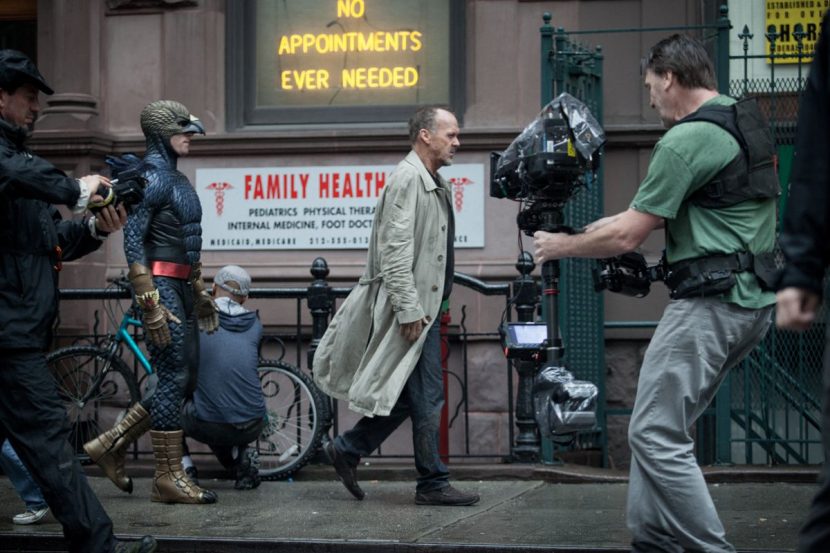
The shot: Hallucinating, Riggan meets Birdman while strolling down the street.
The effects: The scene was played with Keaton walking on a New York street followed by a stuntman dressed in a Birdman suit created by Spectral Motion. Rodeo then augmented the suit, added CG wings and feathers and also grafted Keaton’s face onto the stuntman’s.
Khanikian carried out a photo survey of the wings at Spectral Motion. “We went to their warehouse and we had access to the full suit and wings,” he says. “We did a lot of reference photography there to help build our assets here internally. Then we built the full CG wing assets through Softimage XSI, using the ICE module to add a lot of dynamics and secondary animation to the all of the feathers, so that they had a lot of subtle animation from the wind and movement.” The CG work was overseen at Rodeo by CG supervisor Sebastien Francoeur.
For Birdman’s face, Keaton was filmed performing the dialogue with a three-camera RED EPIC array rigged with flat lighting. Rodeo then used camera projection techniques to re-project that performance back onto a Keaton cyberscan for the final shots.
City attack
The shot: Now imagining the world of Birdman, Riggan conjures up an attack on the city featuring a strange winged creature, helicopters and stray missiles.
The effects: These were added as CG elements into live action plates by Rodeo.
An initial missile hit on a jeep was made up of a practical on-set element featuring a vehicle rigged to rise up and have fire blasting through the windows. Rodeo sim’d the missile and trail in Houdini and then enhanced the explosion with practical fire and debris elements.
The helicopters and additional explosions and missiles were also digital elements. “As we pan up we see the tail of another explosion at the top of the building,” describes Khanikian. “At that point it was just a puff of smoke they had shot for timing, so we did a full sim in Houdini of that building with proper sim’d elements like bricks and plywood and glass falling off. We also had to do a lot of heavy smoke sims and practical fire elements in comp.”
Watch some b-roll from the on-set filming of Birdman.The bird creature, intended to represent a foe that might be typical of a Birdman movie monster, involved significant concept design. “We leaned towards an eagle with a steampunk side to it,” says Khanikian. “It had to feel like a creature that had seen a lot of battle and war and was really dirty and gritty, but perhaps after every single battle it goes back to its base and it soldiers on with extra pieces of metal. It’s a war machine, basically.”
Rodeo relied on Softimage XSI for the creature, and ICE for the feather dynamics. “There was also a lot of little details like dripping saliva and a heatwave coming out of its beak,” notes Khanikian. “And when it was leaning on the side of the building we had a lot of simulated destruction for the pieces that fell down.”
Reflect effect
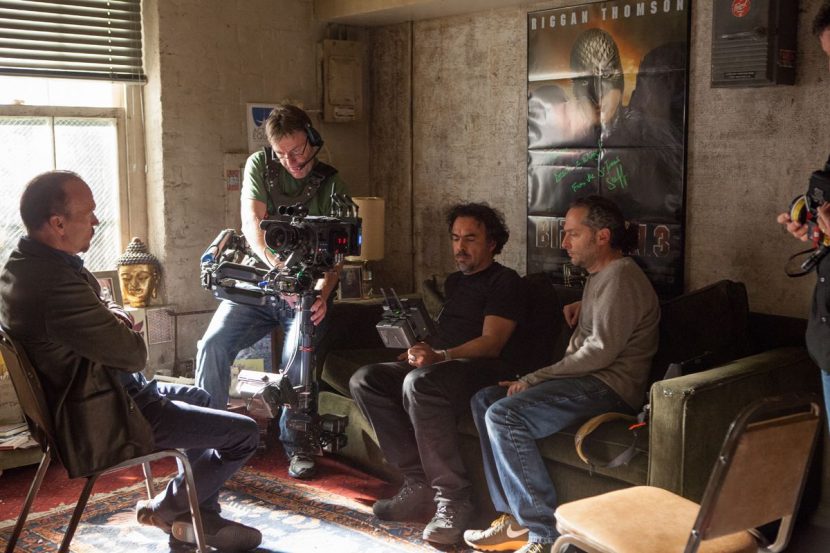
The shot: In several long takes, Riggan is seen contemplating his fate in front of his dressing room mirror, or talking to other characters as the camera moves around them.
The effects: Despite the camera move, no camera or crew are seen in the reflection, since Rodeo rotoscoped out the actors and developed a two-and-a-half-D solution for the reflected environment.
“Every time you’re in the dressing room or anywhere with mirrors, we actually built 2.5D DMP environment of those places,” says Khanikian. “Most of what you see in the mirrors is a matte painting of the environment. The only thing we kept from the plates for those were the rotoscoped foreground actors and their reflections.”
What helps sell the seamless shots are the streaks, smudges and light effects of the mirror. “For that built a little recipe in comp to extract all of those dirt elements,” states Khanikian. “We had some shots where we could clearly see them and we had good extraction of them. In comp we had a little gizmo that would bring back all these dirts in the mirrors, and then just dial them in.”
Additional effects
The shot: Rodeo’s skills were utilized in several other scenes in the film, including key shots of comets entering the Earth’s atmosphere, shots of Riggan trashing his dressing room, various New York environments and in helping to piece together the ‘endless’ takes of the film.
The effects: The comet shots – ultimately representing a falling star – were CG Houdini sims added to live action background plates. “We looked at the Russian comet footage for how the dynamics in it worked,” says Khanikian. “What the director really wanted for those shots was that it was very lively and flickering and sometimes bits of it drift off. In the downtown shot for the comet, in particular, he really wanted to have the comet disintegrating, whereas the other ones are seeing a massive comet through the clouds passing by.”
Riggan suffers a meltdown in his dressing room and begins throwing a number of items around – many of which are shown levitating before they are trashed. “Most of the elements are CG props we added,” notes Khanikian. “There’s the make-up box that he levitates and throws against the wall. The chair he throws on the wall is CG and the poster is full CG throughout the shot. We had photographic reference and we also asked them to send us the props, and we scanned them here ourselves and also did extra reference photography for textures.”
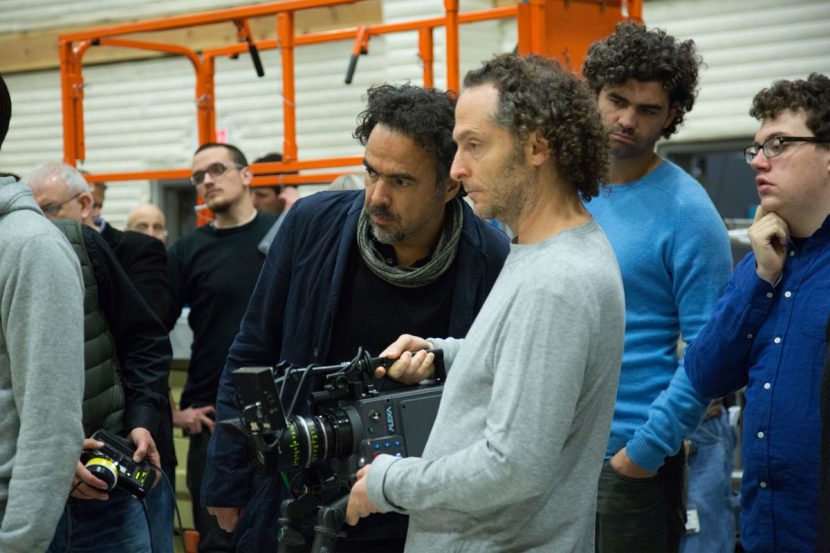
Additional work included some CG crowds for a moment Sam (Emma Stone) and Mike (Edward Norton) share on the theater rooftop. Rodeo also generated CG backgrounds when Riggan is shown in his hospital room.
Rodeo also crafted around 100 stitches to complement the ‘endless’ takes and seamless transitions. One transition in particular – involving a view towards a skyscraper at night that time lapses to the next day – was a two and a half-D matte painting. “When Edward Norton looks up and exhales his cigarette smoke,” explains Khanikian, “we transition to a fully digital background and do a digital timelapse. As the timelapse finishes the camera goes down to almost street level and enters Riggan’s room through a CG window grate.”
“Basically,” adds Khanikian, “from the moment Edward Norton looks up to the moment we enter Riggan’s dressing room, it’s a fully digital reprojected background where we transition between night skyscraper, day skyscraper, dawn building (the one with the metal stairs) as well as that same building shot during daylight. All the different sections were matchmoved, reprojected, and we use a CG camera to seamlessly do the move and tie all the different elements together. As everything is happening, there’s a lot of very precise grading to transition between night and day. Oh, and the birds flying during the timelapse are stock footage elements.”
For some of these long takes, too, the visual effects studio was also called upon to implement selective editing performance visual effects, as well as re-speeds. “Alejandro wanted his movie to have a very precise rhythm and flow,” says Khanikian, “so a huge portion of the movie is re-sped with very intricate timewarp curves to keep up with the pacing that he wanted to maintain.”
The end result was that close to 90 minutes of the film passed through Rodeo’s pipeline – almost all of it as seamless invisible visual effects shots. “That’s what’s great about a movie like this,” notes Khanikian. “We work on big blockbusters which I love doing, but it’s really rewarding working on a movie like this where your work becomes just part of the story. People don’t realize how much work there is in Birdman. It’s there to support the story, which is fantastic.”
